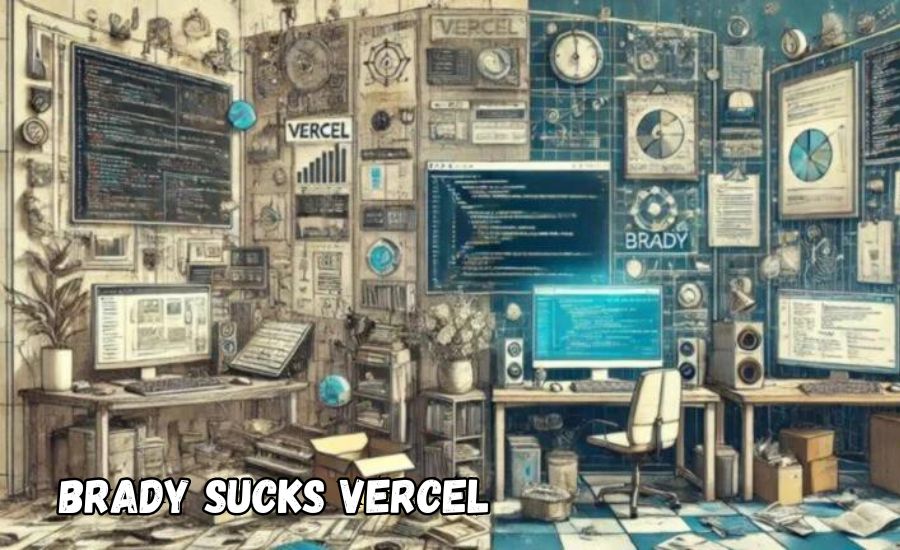Web development is an ever-evolving landscape filled with countless tools and platforms, each vying to provide the best experience for developers. One such platform, Vercel, has been at the forefront of this competition, particularly for front-end developers. It is known for its smooth deployments, serverless functions, as well as its deep connection to Next.js, Vercel is a favourite among many. But, not all users share that same passion.
Enter the phrase “Brady Sucks Vercel”, which has been making waves in online communities. While it may sound harsh, it’s important to understand what drives a developer, or a group of developers, to express such frustration. Is it a critique of the platform, or perhaps just a sign of the challenges that can come with using complex tools?
In this article, we’ll break down the meaning behind “Brady Sucks Vercel,” explore the merits and drawbacks of the platform, and help you make an informed decision about whether Vercel is the perfect choice for your website development needs.
What is “Brady Sucks Vercel” Really About?
At first glance, the phrase “Brady Sucks Vercel” seems like a straightforward complaint from someone who had a bad experience with the platform. But as with many online expressions of frustration, there’s often more to the story.
In this case, “Brady” could be an individual developer who struggled with Vercel’s limitations, or it might represent a broader sentiment among developers facing similar challenges. The phrase has popped up in developer forums, coding groups, and even memes, pointing to some dissatisfaction that developers have experienced when working with Vercel.
While Vercel has many strengths, it’s not uncommon for developers to encounter roadblocks when using new tools—whether it’s due to a steep learning curve, limited backend support, or high costs for larger projects. So, does “Brady Sucks Vercel” reflect a valid critique? To answer that, we need to first take a closer look at what Vercel offers and where it might fall short.
A Quick Look at Vercel: The Platform Overview
Vercel is a cloud platform designed specifically for front-end developers. Its primary purpose is to make it easier for developers to deploy web applications, with a strong focus on speed, scalability, and ease of use. Vercel is particularly well-known for hosting and deploying Next.js applications, a popular framework built on React.
Here’s what Vercel brings to the table:
- Rapid Deployment: With only two clicks developers can install their applications or websites. Vercel automatically optimizes these deployments, ensuring that content is delivered quickly to users around the globe.
- Serverless Functions: Vercel allows developers to add backend functionality to their applications without needing to manage a traditional server. This makes it easy to handle tasks like form submissions, API interactions, and more.
- Edge Network: Vercel’s CDN (Content Delivery Network) ensures that your website is fast, no matter where your users are located. The CDN automatically scales based on traffic, so you don’t have to worry about performance dips during high-traffic periods.
- Next.js Support: Vercel is the official platform for deploying Next.js applications, making it the go-to choice for developers using this framework. Vercel offers tight integration with Next.js, giving developers access to features like real-time preview builds and server-side rendering.
These features make Vercel an attractive option for developers who prioritize speed and simplicity in their deployment process. But like any platform, Vercel isn’t perfect, and that’s where some developers’ frustrations come into play.
Pros of Using Vercel: Why Developers Love It
There’s a reason Vercel is one of the most popular deployment platforms for front-end developers—it’s fast, it’s easy to use, and it offers a range of features that make deploying web applications a breeze. Here are some of the key reasons why developers love using Vercel:
1. Blazing Fast Deployment
One of Vercel’s biggest selling points is its speed. With Vercel, deployments happen almost instantly, meaning you can get your site or app up and running in a matter of seconds. For developers working on projects with tight deadlines, this is a huge advantage. There’s no need to worry about slow deployment times or waiting for your site to go live.
2. Serverless Functions for Simplicity
Vercel’s serverless architecture allows developers to add backend functionality to their applications without having to manage a full server. Whether it’s handling form submissions, querying a database, or interacting with external APIs, Vercel makes it simple to add these features with minimal configuration. This is particularly useful for front-end developers who want to add dynamic functionality to their sites without dealing with the complexity of traditional backend infrastructure.
3. Integration with Next.js and the React Ecosystem
As the official platform for deploying Next.js applications, Vercel offers deep integration with this popular React framework. Developers using Next.js can take full advantage of Vercel’s optimized infrastructure, making it easier to build high-performance web applications. Features like automatic server-side rendering and real-time preview builds are just a few of the ways Vercel enhances the development experience for Next.js users.
4. Collaboration and Preview Deployments
Vercel’s preview deployment feature allows teams to collaborate more effectively by giving everyone involved in the project access to real-time updates. Team members can share links to preview builds, making it easier to get feedback and make changes before the site goes live. This feature is especially useful for larger projects where multiple people are working on the same codebase.
While these features make Vercel a top choice for many developers, it’s not without its drawbacks. Let’s explore some of the common criticisms that might lead to sentiments like “Brady Sucks Vercel.”
Also Read: Mygreenbucks-Net
Common Complaints About Vercel: The Source of Developer Frustration

Despite its many advantages, Vercel isn’t a one-size-fits-all solution. Some developers have encountered challenges when using the platform, which could explain why phrases like “Brady Sucks Vercel” have emerged in the first place. Let’s take a look at some of the most common complaints developers have about Vercel:
1. Cost Structure and Scalability
While Vercel offers a generous free tier, developers who work on larger projects or have high-traffic sites may find the pricing model less than ideal. As your project scales, costs can quickly add up, which can be a source of frustration for developers working with limited budgets. The pay-as-you-go model means that unexpected traffic spikes can result in hefty bills, something that might catch developers off guard.
2. Limited Backend Capabilities
While Vercel excels at front-end deployment, its backend capabilities are somewhat limited. For developers who need more robust backend functionality—such as managing databases, handling complex business logic, or building full-stack applications—Vercel may not be the best choice. This limitation could explain why developers like “Brady” might feel frustrated when they hit the platform’s backend ceiling.
3. Dependency on Next.js
Vercel is heavily optimized for Next.js, which is great for developers using this framework but may be a downside for those working with other technologies. While Vercel does support other front-end frameworks, it doesn’t offer the same level of optimization and integration as it does with Next.js. Developers using Angular, Vue.js, or other frameworks may feel that Vercel is biased towards Next.js, limiting their flexibility.
4. Learning Curve for New Developers
Although Vercel aims to simplify the deployment process, it’s not entirely beginner-friendly. Developers who are new to serverless architectures or unfamiliar with Next.js may find Vercel’s features confusing or difficult to navigate. The platform’s documentation, while thorough, can still be overwhelming for those just getting started.
Exploring “Brady Sucks Vercel”: An Analysis of Developer Frustration

Now that we’ve explored Vercel’s strengths and weaknesses, let’s dive deeper into why a developer like “Brady” might express frustration with the platform. What are the real-world scenarios that could lead to a sentiment like “Brady Sucks Vercel”?
Example 1: Cost Overruns Due to Traffic Spikes
Imagine a developer working on a small e-commerce site that suddenly goes viral. Traffic spikes, and what started as a project with minimal costs suddenly results in a significant bill. This is a scenario where Vercel’s pay-as-you-go pricing model can catch developers off guard, especially if they didn’t anticipate high levels of traffic.
Example 2: Limitations with Backend Functionality
Let’s say “Brady” is working on an application that requires more complex backend operations, such as managing user authentication or handling payments. Vercel’s serverless functions, while useful for simple tasks, may not be robust enough for these requirements. In this case, “Brady” might feel that Vercel’s backend limitations are holding back their project, leading to frustration.
Example 3: Struggling with the Learning Curve
New developers or those unfamiliar with Next.js might struggle to get the most out of Vercel. If “Brady” is relatively new to web development, the combination of serverless architecture, CDN configurations, and framework-specific optimizations might feel overwhelming.
Conclusion
The phrase “Brady Sucks Vercel” likely stems from frustrations that some developers have faced when using Vercel, such as its pricing structure, backend limitations, or learning curve. However, it’s important to remember that Vercel remains a leading platform for front-end developers, particularly those working with Next.js. It offers fast, seamless deployments, integrated serverless functions, and robust global CDN support, making it an ideal choice for many projects. While it may not be perfect for every developer or use case, Vercel’s strengths often outweigh its drawbacks. For developers focused on front-end development, the platform’s advantages far outshine the occasional frustrations. Ultimately, whether “Brady Sucks Vercel” is justified depends on individual needs, but Vercel remains a strong contender in modern web development.
FAQs
Q: What does “Brady Sucks Vercel” mean?
A: “Brady Sucks Vercel” is an expression found in developer communities, potentially reflecting frustration with Vercel’s platform by a user named Brady or a group of developers.
Q: Why do some developers criticize Vercel?
A: Some developers criticize Vercel for its pricing, backend limitations, and dependency on Next.js, which can make it less flexible for non-React-based projects.
Q: Is Vercel good for web development?
A: Yes, Vercel is great for front-end developers, especially those working with Next.js and React-based applications. It provides fast deployment and scalable solutions.
Q: What are the limitations of Vercel?
A: Vercel’s main limitations include its cost for high-traffic sites, limited backend functionality, and a steep learning curve for beginners or those unfamiliar with serverless architectures.
Q: Are there alternatives to Vercel?
A: Yes, platforms like Netlify and Heroku offer similar services, though Heroku may provide better backend support, and Netlify is another good option for static sites and serverless functions.
Stay informed with the latest news and updates on Dallasinsiders.com
